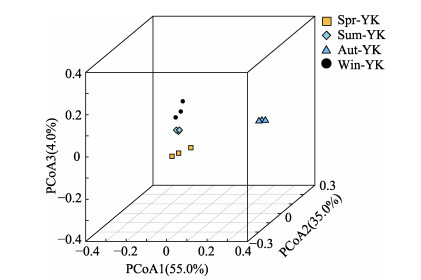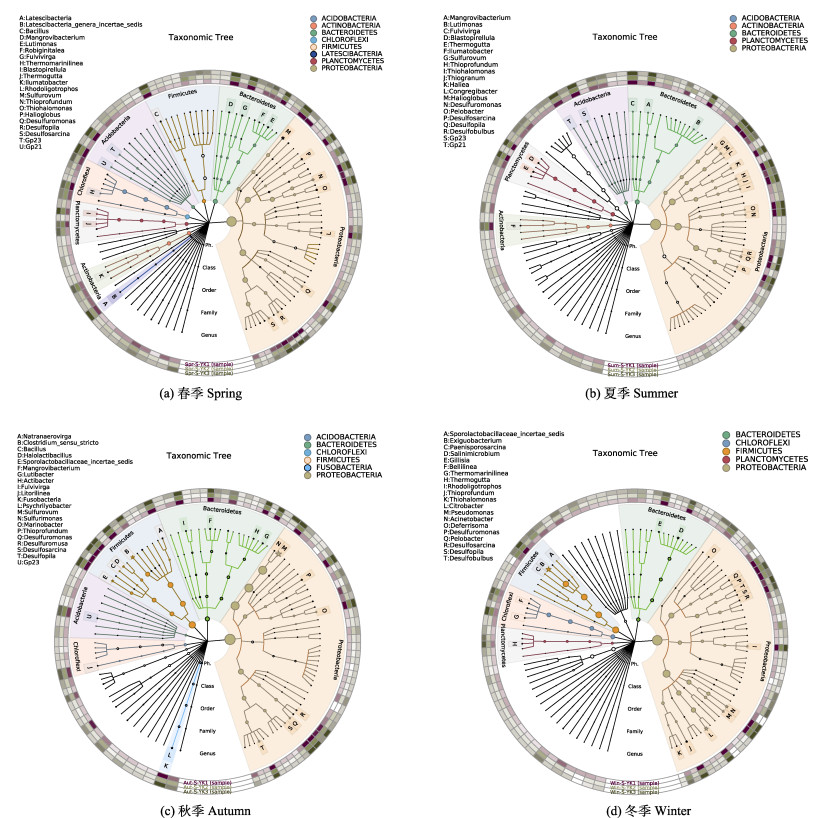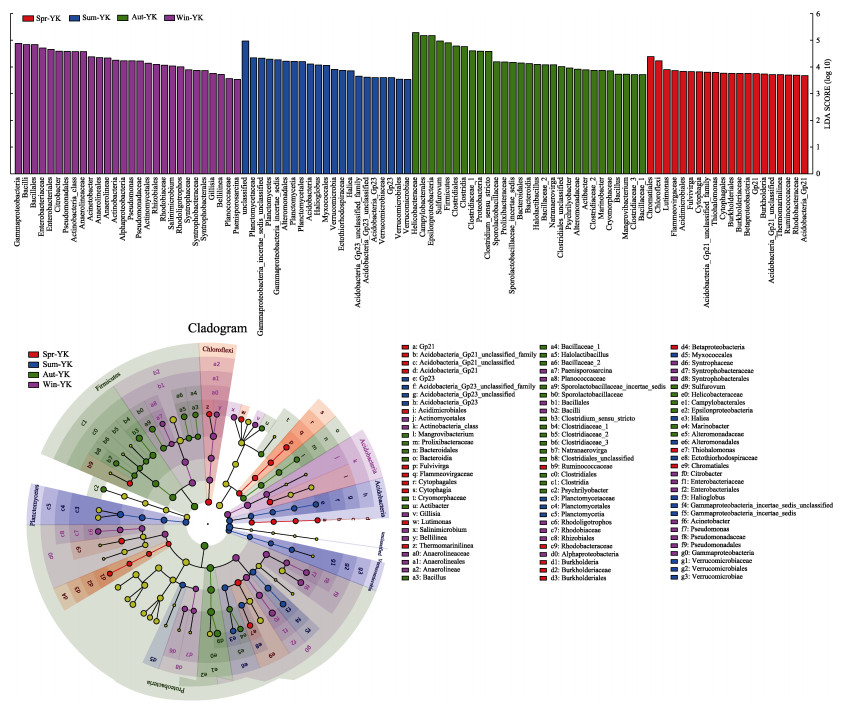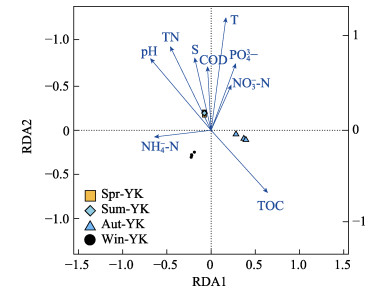刺参(Apostichopus japonicus)因具有丰富的营养和药用价值,深受消费者青睐。随着刺参养殖产业的不断发展,池塘养殖已成为刺参增养殖的重要方式(常亚青等, 2006)。在集约化养殖过程中,残饵及养殖生物粪便的堆积易引起底质恶化,对养殖生态系统健康存在潜在危害(董双林, 2015; 王姣, 2016)。
养殖池塘沉积物菌群作为养殖生态系统的重要组成部分,不仅在水体物质循环及能量流动过程中发挥巨大的作用(Bentzon-Tilia et al, 2016),对其养殖生物的生长、消化、免疫、疾病等均存在相关性(Becker et al, 2004; Wang et al, 2005; 高菲等, 2010)。研究表明,蓝细菌(Cyanobacteria)能将溶解有机碳转化为自身的颗粒有机碳,从而完成碳转换与储存(周伟华等, 2007);假单胞菌属(Pseudomonas)菌群能利用反硝化作用将硝酸盐还原为氮气(肖晶晶等, 2009);链霉菌属(Streptomyces)、芽孢杆菌属(Bacillus)、节杆菌属(Arthrobacter)中某些菌种对有机磷和无机磷的分解具有明显作用(孙亚凯, 2006);脱氮硫杆菌(Thiobacillus denitrificans)、反硝化硫微螺菌(Thiomicrospira denitrificans)、多样硫杆菌(Thiobacillusd versutus)等菌群能从多种还原态无机硫的氧化中获得能量,同时,还原硝酸盐或亚硝酸盐产生氮气(Pokorna et al, 2015);嘉利翁氏菌属(Gallionella)、海杆菌属(Mariprofundus)、Sideroxydans能够将Fe2+氧化为Fe3+,而Fe3+可以作为电子受体进行能量代谢,从而完成铁循环(Edwards et al, 2003; Emerson et al, 2004)。因此,有效利用某些微生物的生理功能来保持养殖池塘生态系统的微生态平衡,对防治池塘养殖环境恶化以及促进养殖生物健康生长具有重要意义(王鑫毅等, 2019)。然而,养殖池塘生态系统菌群结构极易受到外部环境理化因子的影响,季节变动、营养物质输入等变化均可造成池塘养殖环境菌群种类和丰度的改变,间接影响养殖生物的生长及健康(Sunde et al, 2001; Suzuki et al, 2019)。
为探明不同季节刺参养殖池塘沉积物菌群结构及其影响因素,本研究选取辽宁省营口地区刺参养殖池塘为研究对象,基于高通量测序技术,揭示不同季节刺参养殖池塘沉积物菌群结构的季节性差异和共性,查明影响刺参养殖池塘沉积物菌群结构的主导环境因子,以期为刺参养殖池塘微生态调控和绿色健康养殖提供一定的理论依据。
1 材料与方法 1.1 样品采集选取辽宁营口(40°37'46" N;122°8'59" E)刺参养殖池塘为研究对象,于2019年1月(冬季)、4月(春季)、8月(夏季)、10月(秋季),利用柱状采泥器,在同一刺参养殖池塘对角线两侧离岸1.5 m及正中间处采集表层(5 cm)沉积物样品,装入无菌离心管,–80℃冷冻保存。将每次采集的5个沉积物样品等量混匀送检,每个样品进行3次重复。
采样池塘仅养殖刺参单一品种,放养刺参密度约为8~10头/m2,刺参规格约为100 g/头。池塘面积约为0.1 km2,水深2~3 m,底质多泥质,水源来自近海海域,利用潮汐带来的潮差进水和排水。全年不投喂饲料及益生菌,保证刺参自然生长。
1.2 环境因子测定环境因子监测点位同沉积物采样点,每个采样点测定环境指标均进行3次重复。采用HACH(HQd)水质分析仪器,在养殖池塘现场测定温度、盐度和pH。沉积物总有机碳(TOC)的测定采用重铬酸钾氧化–还原容量法,总氮(TN)采用过硫酸钾氧化法,总磷(TP)采用钼锑抗分光光度法,氨氮(NH4+-N)采用次溴酸盐氧化法,硝酸盐(NO3–-N)采用镉柱还原法,亚硝酸盐(NO2–-N)采用萘乙二胺分光光度法,磷酸盐(PO43–-P)采用磷钼蓝分光光度法,硫化物采用亚甲基蓝分光光度法,氧化还原电位采用碱性高锰酸钾法。
1.3 DNA提取选用OMEGA Soil DNA试剂盒提取刺参养殖池塘环境样品总DNA,为确保DNA无降解无污染,DNA浓度要求≥50 ng/μl,OD260/280=1.8~2.0。利用1%琼脂糖凝胶电泳检测DNA,条带清晰完整、无拖尾,质量合格。
1.4 PCR扩增与高通量测序细菌16S rRNA基因V3~V4片段的扩增引物为341F(5'-CCTACGGGNGGCWGCAG-3')和805R(5'-G ACTACHVGGGTATCTAATCC-3'),应用Illumina MiSeq测序平台完成序列测序。
1.5 数据分析采用Usearch软件,以97%阈值开展OTU(Optical Transform Unit)操作分类单元聚类(Blaxter et al, 2005)。选用RDP classifier软件(Wang et al, 2007)进行物种分类操作,阈值设置为0.8,低于该阈值的分类结果被划归为Unclassified一类。利用Qiime软件(Caporaso et al, 2010)进行多样性分析。基于OTU聚类和环境因子信息,利用R语言的Vegan package (Oksanen et al, 2010)进行环境因子相关性分析。通过最大似然法构建进化树。根据物种分类结果得到不同水平上各Rank的丰度值,采用STAMP软件(版本2.1.3),比较样本之间丰度差异,P < 0.05为差异显著,比较样本组间丰度差异。
2 结果与分析 2.1 环境因子监测辽宁营口刺参养殖池塘不同季节沉积物环境因子监测数据如表 1所示。根据中华人民共和国国家标准《海洋沉积物质量(GB 18668-2002)》,所有样品均符合国家Ⅰ类沉积物标准。所监测的环境因子理化指标,均呈显著的季节性差异。其中,总氮、氨氮、硝酸盐、总磷和硫化物含量均在夏季最高;TOC含量在秋季最高,春季最低。
|
|
表 1 不同季节刺参养殖池塘沉积物环境因子 Tab.1 Environmental factors of sediment in Apostichopus japonicus culture pond in different seasons |
不同季节刺参养殖池塘沉积物样品高通量测序结果见表 2,从表 2可以看出,共得到原始序列37690~87024条,有效序列41562~79288条,聚类于36980~3913个OTUs。样品测序覆盖率为95.9%~ 99.6%,表明测序结果可以真实反映样本信息。稀释曲线趋于平坦,表示测序数据深度足够反映样品的多样性。
|
|
表 2 高通量测序结果 Tab.2 Results of high-throughput sequencing |
Chao1和Ace指数常用于估算样品中菌群的丰度;Shannon和Simpson指数常用于估算样品中菌群的多样性。
比较不同季节α多样性指数得出(图 1),营口地区刺参养殖池塘沉积物菌群丰度和多样性具有显著性季节差异。其中,夏季菌群丰度和多样性显著升高;其他季节菌群丰度和多样性均有不同程度的下降,具体表现为秋冬两季菌群丰度极显著性下降(P < 0.01),且冬季菌群物种丰度达四季最低。

|
图 1 α多样性指数 Fig.1 Alpha diversity index |
在OTU水平上,根据加权Unifrac距离对不同季节样本进行三维主坐标分析(图 2)。其中,PCoA1 (Principal Co-ordinates analysis)的贡献率为55%,PCoA2的贡献率为35%,PCoA3的贡献率为4%,总贡献率为94%。同一季节样品均聚集在一起,显示出较好的生物学重复性。不同季节相比较,秋季与其他季节沉积物菌群结构具有显著差异(P < 0.05)。

|
图 2 PCoA三维分析 Fig.2 PCoA three-dimensional analysis |
基于GraPhlAn分类和系统发育信息可视化图(图 3)可以看出,不同季节刺参养殖池塘沉积物第一优势菌门均为变形菌门(Proteobacteria)(相对丰度 > 43.19%),次优势菌门存在显著差异。其中,绿弯菌门(Chloroflexi)(相对丰度 > 7%)为春季次优势菌门;拟杆菌门(Bacteroidetes)(相对丰度 > 8.13%)为夏季次优势菌门,厚壁菌门(Firmicutes)(相对丰度 > 17.96%)为秋、冬季次优势菌门。
菌属水平下,优势菌属呈现出显著的季节性差异(P < 0.05)。其中,春季优势菌主要隶属于Sulfurovum、Thioprofundum、除硫单胞菌属(Desulfuromonas)、Desulfosarcina和Desulfopila。夏季优势菌属主要隶属于Sulfurovum、Halioglobus、Haliea、Thioprofundum、Desulfuromonas、Desulfopila和Desulfobulbus。秋季优势菌主要隶属于Sulfurovum、Desulfuromonas、Desulfuromusa、Desulfosarcina、Desulfopila和海杆菌属(Marinobacter)。冬季优势菌主要隶属于柠檬酸杆菌属(Citrobacter)、假单胞菌属(Pseudomonas)、Desulfuromonas、Pelobacter、Desulfosarcina、Desulfopila、Desulfobulbus、不动杆菌属(Acinetobacter)和Exiguobacterium。春、夏、秋、冬4季沉积物优势菌属均包含脱硫八叠菌Desulfosarcina、Desulfuromonas和Desulfopila。

|
图 3 不同季节沉积物菌群相对丰度
Fig.3 Relative abundance of sediment bacterial community in different seasons
图中是丰度前100个物种的进化分类树,并将丰度前20个物种所对应的门按不同颜色标出,圈的大小代表丰度大小。外围为热力图,每个环为一个样本,每个样本对应一种颜色,颜色深浅随物种丰度变化
The top 100 species were classified into taxonomic trees, and the top 20 phyla were marked with different colors, and the size of the circle represented the abundance. Each ring is a sample, and each sample corresponds to a color. The color depth varies with species richness |
LEfSe (LDA Effect Size)差异性分析结果显示(图 4),共有不同分类水平的98个细菌群类在4个季节中存在显著差异。其中,变形菌门在4个季节中都存在差异菌群,如柠檬酸杆菌属、不动杆菌属、假单胞菌属是隶属于春季的差异菌属;外硫红螺旋菌科(Ectothiorhodospiraceae)、交替单胞菌目(Alteromonadales)是隶属于夏季的差异菌目;弯曲菌目(Campylobacterales)、Sulfurovum是隶属于秋季的差异菌;着色菌目Chromatiales、Thiohalomonas是隶属于冬季的差异菌目。此外,春季刺参养殖池塘沉积物差异菌门主要隶属于拟杆菌门(Bacteroides)和酸杆菌门(Acidobacteria),其代表性差异菌属分别为Cytophagla和Gp21。夏季沉积物差异菌门主要隶属于酸杆菌门、疣微菌门(Verrucomicrobia)和浮霉菌门(Planctomycetes),分别以Gp23、疣微菌科(Verrucomicrobiaceae)和浮霉菌科(Planctomycetaceae)为代表。秋季沉积物差异菌门隶属于拟杆菌门和厚壁菌门,其代表性差异菌属为Mangrovibacterium和Natranaerovirga。冬季沉积物差异菌门则隶属于放线菌门(Actinobacteria)以Actinomycetales为代表。

|
图 4 不同季节沉积物菌群LEfSe分析 Fig.4 LEfSe analysis of sediment bacterial community in different seasons 图中不同颜色代表不同分组,树枝中不同颜色节点表示在该颜色对应分组中起到重要作用的微生物类群。黄色节点表示未起到重要作用的微生物类群。图中英文字母表示的物种名称在右侧图例中进行展示 Different colors represent different groups, and different color nodes in the tree represent the microbial groups that play an important role in the corresponding color groups. The Yellow nodes indicate microbial groups that do not play an important role. The species names in English letters are shown in the legend on the right |
RDA是将对应分析与多元回归分析混合的一种分析方法。营口地区刺参养殖池塘沉积物菌群与环境因子RDA(Redundancy Analysis)分析结果显示(图 5),春季和夏季在第2象限中基本处于同一位置,显示影响春夏两季沉积物菌群结构的环境因子相似。根据环境因子与原点连线的长度可知,温度、TN、pH和TOC是营口刺参养殖池塘沉积物菌群的主导环境因子。其中,温度、TN、pH与春、夏季刺参养殖池塘沉积物菌群相对丰度呈正相关,与秋、冬季菌群相对丰度呈负相关;TOC与秋、冬季刺参养殖池塘菌群相对丰度呈正相关,与春、夏季菌群相对丰度呈负相关。

|
图 5 沉积物菌群与环境因子RDA分析 Fig.5 RDA analysis of sediment bacterial community and environmental factors |
不同季节刺参养殖池塘沉积物差异菌群与主导环境因子相关性分析结果见表 3。其中,拟杆菌门与TOC含量呈极显著负相关(P < 0.01),表明拟杆菌门受沉积物有机物质含量影响显著。酸杆菌门与pH和TN呈极显著正相关(P < 0.01)。疣微菌门和浮霉菌门与TN含量呈极显著正相关(P < 0.01)。厚壁菌门与TN呈极显著负相关(P < 0.01),与TOC含量呈极显著正相关(P < 0.01)。放线菌门则与pH和TOC呈显著相关性(P < 0.05)。
|
|
表 3 沉积物优势菌群与主导环境因子相关性分析 Tab.3 Correlation analysis between dominant bacterial community and environment factors in sediment |
微生物是养殖池塘生态系统的重要组成部分,在生态系统物质循环和能量流动过程中发挥着重要作用,对维持生态系统平衡具有重要意义(Rungrassamee et al, 2016; Xiong et al, 2016; 金笑等, 2017)。本研究结果显示,营口地区不同季节刺参养殖池塘沉积物菌群丰度和多样性呈现出显著的季节演替特征。其中,夏季刺参养殖池塘沉积物菌群丰度和多样性最高,冬季沉积物菌群丰度和多样性则最低。已有的研究表明,温度是影响环境微生物生命活动的重要因素之一,高温通过加速细菌体内酶活性,促进微生物代谢,加速有机物分解,为微生物生长繁殖提供有利条件(李彬等, 2010; Cardona et al, 2016)。同时,氮、磷等营养物质的增多,也为细菌生长创造了适宜的条件,使菌群丰度和多样性更丰富(董学兴等, 2019)。营口地区夏季刺参养殖池塘水环境温度和氮磷含量相对较高,为沉积物中微生物的繁殖提供了良好的生存环境,因此,夏季沉积物菌群丰度和多样性显著高于其他季节。
3.2 不同季节刺参养殖池塘沉积物菌群结构及其影响因素本研究中,不同季节营口地区刺参养殖池塘沉积物第1优势菌门均为变形菌门,与已有的研究报道一致(窦妍等, 2014、2016; 丁斯予等, 2019)。变形菌门作为养殖池塘环境中的第1优势菌门,主要是由其在原核生物分子生物学分类中的绝对优势所决定的(Gupta et al, 2000)。变形菌门下多个细菌群类均为池塘底栖环境中常见的固氮菌,参与池塘生态系统氮循环,在池塘养殖生态系统中占据着重要的生态学地位(刘思亮等, 2002; 龚骏等, 2010)。刺参养殖池塘沉积物除变形菌门为第1优势菌门外,其他优势菌门为拟杆菌门、酸杆菌门、疣微菌门、厚壁菌门等,与营底栖生活的缢蛏(Sinonovacula constricta)相近(王毅鑫等, 2019),与杂食性的罗非鱼池塘沉积物菌群差别较大(史丽娜等, 2015)。养殖品种食性的差异会导致饲料投入不同,造成池塘沉积物中有机物和营养盐浓度产生差异。除饲料不同之外,刺参的摄食方式为吞食沉积物,造成沉积物菌群结构发生一定改变(于东祥, 2010)。因此,刺参养殖池塘沉积物菌群结构具有特异性。
比较不同季节刺参养殖池塘沉积物菌群结构特征的结果显示,刺参养殖池塘沉积物菌群存在显著的季节性差异,特异性菌群相对丰度与其生境因子之间存在显著性相关,影响沉积物菌群的主导环境因子为温度、TOC、TN和pH,且所有主导环境因子均呈现出显著的地域差异。已有的研究表明,微生物生长繁殖所需的营养物质主要依靠环境中的无机盐和有机物,其群落组成对环境因子变化有着较强的敏感性(王轶南等, 2010; Bell et al, 2013; 李建光等, 2014; Yang et al, 2015; Amabebe et al, 2020)。微生物菌群特征是其生境的反映,与环境理化性质密切相关且相互限制影响(闫法军等, 2014)。其中,春季刺参养殖池塘沉积物特异性菌群主要以拟杆菌门为代表。拟杆菌门细菌与微生物蛋白质和脂类等有机物的转化密切相关(Ren et al, 2015),是维持环境碳循环的主要动力,且与春季沉积物环境中TOC含量显著性相关。夏季沉积物特异性菌群以酸杆菌门、疣微菌门和浮霉菌门为代表。夏季随着温度的升高,养殖生物代谢加快,排泄物增多,易导致硫、铁等元素在池底大量堆积,使养殖池塘底部沉积物pH下降,为具有嗜酸特性的酸杆菌门繁殖提供了有利条件(Barns et al, 2007; 刘彩霞等, 2016)。此外,夏季沉积物中含氮物质的增高会造成水体富营养化,导致蓝藻暴发,也会对水生生物的生长产生不良影响(付莹等, 2018)。然而,疣微菌门细菌的存在可以有效利用夏季沉积物环境中的氮元素,加速氮循环进程(Shen et al, 2017)。夏季沉积环境中高含量的氮和硫,则有利于浮霉菌门细菌的生长繁殖(黄佩蓓等, 2014)。厚壁菌门细菌能够有效利用环境中硝酸盐和亚硝酸盐,进而降低沉积物中的氮含量,作为秋季特异性菌群,与其沉积物中较低的氮含量呈现出一致性。冬季随着气温的下降,沉积物中微生物丰度和多样性均受到不同程度的抑制,而放线菌门细菌因能形成抗逆性极强的芽孢,从而具有极强的环境适应性(王蓉等, 2013),成为冬季沉积物特异性菌群。此外,放线菌门具有降解淀粉、蛋白等大分子的功能,产生的抗菌素类物质能抑制环境中其他革兰氏阳性细菌发挥作用,有成为益生菌的潜力(李文均等, 2002)。
值得注意的是,夏季刺参养殖池塘沉积物中厚壁菌门相对丰度极显著低于其他季节,相对丰度仅为0.5%。而隶属于厚壁菌门、芽孢杆菌目(Bacillales)的芽孢杆菌属是典型的益生菌,被广泛用于水产养殖池塘环境微生态调控(杜佗等, 2017)。芽孢杆菌可以产生多种消化酶和营养物质,供养殖动物吸收利用,还可以通过改善水产动物体内微生态环境进而提高动物机体免疫力,同时,具有净化水质和清除自由基的功效(苏艳莉等, 2016)。因此,建议在夏季池塘中添加适当含量的芽孢杆菌,用于协助刺参安全度夏。
4 结论本研究结果表明,营口地区刺参养殖池塘沉积物菌群丰度和多样性存在显著性季节变化特征,温度、总有机碳、总氮和pH是影响沉积物菌群的主要环境因子。本研究初步探明沉积物菌群与主导环境因子间的相关性,而菌群与环境因子间的互作机制还有待于进一步深入探究。
Amabebe E, Robert FO, Agbalalah T, et al. Microbial dysbiosis- nduced obesity role of gut microbiota in homeostasis of energy metabolism. British Journal of Nutrition, 2020, 123(10): 1-23 |
Barns SM, Cain EC, Sommerville L, et al. Acidobacteria phylum sequences in uranium-contaminated subsurface sediments greatly expand the known diversity within the phylum. Applied and Environmental Microbiology, 2007, 73(9): 3113-3116 DOI:10.1128/AEM.02012-06 |
Becker P, Gillanb D, Lanterbecq D, et al. The skin ulceration disease in cultivated juveniles of Holothuria scabra. Aquaculture, 2004, 242(1): 13-30 |
Bell TH, Yergeau E, Maynard C, et al. Predictable bacterial composition and hydrocarbon degradation in Arctic soils following diesel and nutrient disturbance. International Society for Microbial Ecology Journal, 2013, 7(6): 1200-1210 |
Bentzon-Tilia M, Sonnenschein EC, Gram L. Monitoring and managing microbes in aquaculture-towards a sustainable industry. Microbial Biotechnology, 2016, 9(5): 576-584 DOI:10.1111/1751-7915.12392 |
Blaxter M, Mann J, Chapman T, et al. Defining operational taxonomic units using DNA barcode data. Philosophical Transactions of the Royal Society of London, 2005, 360(1462): 1935-1943 DOI:10.1098/rstb.2005.1725 |
Caporaso JG, Kuczynski J, Stombaugh J, et al. QⅡME allows analysis of high-throughput community sequencing data. Nature Methods, 2010, 7(5): 335-336 DOI:10.1038/nmeth.f.303 |
Cardona E, Gueguen Y, Magré K, et al. Bacterial community characterization of water and intestine of the shrimp Litopenaeus stylirostris in a biofloc system. BMC Microbiology, 2016, 16(1): 157 DOI:10.1186/s12866-016-0770-z |
Chang YQ, Sui XL, Li J. The current situation, problem and prospect on the Apostichopus japonicus aquaculture. Fisheries Science, 2006, 25(4): 198-201 [常亚青, 隋锡林, 李俊. 刺参增养殖现状、存在问题和展望. 水产科学, 2006, 25(4): 198-201 DOI:10.3969/j.issn.1003-1111.2006.04.010] |
Ding SY, Wang L, Xu HC, et al. Bacterial community structure and function in the intestinal tracts and culture environment of sea cucumber (Apostichopus japonicus). Chinese Journal of Ecology, 2019, 38(1): 210-220 [丁斯予, 王荦, 徐翰晨, 等. 刺参肠道及养殖环境菌群结构与功能. 生态学杂志, 2019, 38(1): 210-220] |
Dong SL. On ecological intensification of aquaculture systems in China. Chinese Fisheries Economics, 2015, 33(5): 4-9 [董双林. 论我国水产养殖业生态集约化发展. 中国渔业经济, 2015, 33(5): 4-9 DOI:10.3969/j.issn.1009-590X.2015.05.001] |
Dong XX, Lü LL, Zhao WH, et al. Effects of different cultural patterns on microbial communities in the intestine of Macrobrachium rosenbergii and interactions with environment factors. Journal of Shanghai Ocean University, 2019, 28(4): 501-510 [董学兴, 吕林兰, 赵卫红, 等. 不同养殖模式下罗氏沼虾肠道菌群结构特征及其与环境因子的关系. 上海海洋大学学报, 2019, 28(4): 501-510] |
Dou Y, Ding J, Wang YN, et al. Flora diversity in intestine and culture ponds in sea cucumber Apostichopus japonicus in Yellow Sea and Bohai in spring. Journal of Dalian Ocean University, 2014, 29(6): 572-576 [窦妍, 丁君, 王轶南, 等. 黄、渤海春季刺参肠道及养殖池塘细菌菌群的多样性. 大连海洋大学学报, 2014, 29(6): 572-576 DOI:10.3969/J.ISSN.2095-1388.2014.06.006] |
Dou Y, Zhao XW, Ding J, et al. Application of high-throughput sequencing for analyzing bacterial communities in earthen ponds of sea cucumber aquaculture in northern China. Oceanologia et Limnologia Sinica, 2016, 47(1): 122-129 [窦妍, 赵晓伟, 丁君, 等. 应用高通量测序技术分析北方刺参养殖池塘环境菌群结构. 海洋与湖沼, 2016, 47(1): 122-129] |
Du T, Li B, Wang YG, et al. Screening and characteristic analysis of potential probiotics from large water ponds used for sea cucumber (Apostichopus japonicus) farming. Progress in Fishery Sciences, 2017, 38(3): 180-187 [杜佗, 李彬, 王印庚, 等. 刺参大面积养殖池塘环境中优势益生菌筛选及其特征分析. 渔业科学进展, 2017, 38(3): 180-187] |
Edwards KJ, Rogers DR, Wirsen CO, et al. Isolation and characterization of novel psychrophilic, neutrophilic, Fe-oxidizing, chemolithoautotrophic α- and γ-Proteobacteria from the deep sea. Applied and Environmental Microbiology, 2003, 69(5): 2906-2913 DOI:10.1128/AEM.69.5.2906-2913.2003 |
Emerson D, Weiss JV. Bacterial iron oxidation in circumneutral freshwater habitats: Findings from the field and the laboratory. Geomicrobiology Journal, 2004, 21(6): 405-414 DOI:10.1080/01490450490485881 |
Fu Y, Zhao YR. A review: Toxicity of ammonia and detoxification of ammonia in fish. Chinese Journal Fisheries, 2018, 31(3): 49-54 [付莹, 赵玉蓉. 氨氮对鱼类的毒性及鱼类应对氨氮毒性的策略. 水产学杂志, 2018, 31(3): 49-54 DOI:10.3969/j.issn.1005-3832.2018.03.011] |
Gao F, Sun HL, Xu Q, et al. PCR-DGGE analysis of bacterial community composition in the gut contents of Apostichopus japonicus. Journal of Fishery Sciences of China, 2010, 17(4): 55-64 [高菲, 孙慧玲, 许强, 等. 刺参消化道内含物细菌群落组成的PCR-DGGE分析. 中国水产科学, 2010, 17(4): 55-64] |
Gong J, Song YT, Zhang XL. Phylogenetic and function diversity of nitrogen cycling microbes in coastal sediments. Biodiversity Science, 2013, 21(4): 433-444 [龚骏, 宋延静, 张晓黎. 海岸带沉积物中氮循环功能微生物多样性. 生物多样性, 2013, 21(4): 433-444] |
Gupta RS. The phylogeny of proteobacteria: Relationships to other eubacterial phyla and eukaryotes. FEMS Microbiology Reviews, 2000, 24(4): 367-402 DOI:10.1111/j.1574-6976.2000.tb00547.x |
Huang PB, Jiao NZ, Feng J, et al. Research progress on Planctomycetes' diversity and ecological function in marine environments. Microbiology China, 2014, 41(9): 1891-1902 [黄佩蓓, 焦念志, 冯洁, 等. 海洋浮霉状菌多样性与生态学功能研究进展. 微生物学通报, 2014, 41(9): 1891-1902] |
Jin X, Kou WB, Yu HT, et al. Environmental factors influencing the spatial distribution of sediment bacterial community structure and function in Panyang Lake. Research of Environment Sciences, 2017, 30(4): 529-536 [金笑, 寇文伯, 于昊天, 等. 潘阳湖不同区域沉积物细菌群落结构、功能变化及其与环境因子的关系. 环境科学研究, 2017, 30(4): 529-536] |
Li B, Rong XJ, Liao MJ, et al. Bacteria community in the intestine and culture environment of Apostichopus japonicus in winter. Marine Science, 2010, 34(4): 64-69 [李彬, 荣小军, 廖梅杰, 等. 冬季刺参养殖环境与肠道内细菌菌群的研究. 海洋科学, 2010, 34(4): 64-69] |
Li JG, Xu YP, Li XY, et al. Characterization of bacterial communities associated with the intestinal tracts and culture environment of sea cucumber (Apostichopus japonicus) in different culture seasons. Fisheries Science, 2014, 33(9): 562-568 [李建光, 徐永平, 李晓宇, 等. 不同养殖季节仿刺参肠道与养殖环境中菌群结构的特点. 水产科学, 2014, 33(9): 562-568 DOI:10.3969/j.issn.1003-1111.2014.09.005] |
Li WJ, Zhang ZZ, Jiang CL. The advance on taxonomic of genus Thermoactinomyces. Acta Microbiologica Sinica, 2002, 42(6): 759-763 [李文均, 张忠泽, 姜成林. 高温放线菌属分类研究进展. 微生物学报, 2002, 42(6): 759-763 DOI:10.3321/j.issn:0001-6209.2002.06.020] |
Liu CX, Dong YH, Jiao RZ. Research progress in Acidobacteria diversity in forest soil. World Forestry Research, 2016(6): 17-22 [刘彩霞, 董玉红, 焦如珍. 森林土壤中酸杆菌门多样性研究进展. 世界林业研究, 2016(6): 17-22] |
Liu SL, Liu CQ, Xiao HY. Microbial effect on nitrogen cycle and nitrogen isotope fractionation on the earth's surface: A review. Geology Geochemistry, 2002, 30(4): 40-45 [刘思亮, 刘丛强, 肖华云. 地表环境氮循环过程中微生物作用及同位素分馏研究综述. 地质地球化学, 2002, 30(4): 40-45 DOI:10.3969/j.issn.1672-9250.2002.04.007] |
Oksanen J, Blanchet FG, Kindt R, et al. Vegan: Community ecology package. R package version 1.18-2. Time International, 2010, 1997(6): 15-17 |
Pokorna D, Zabranska J. Sulfur-oxidizing bacteria in environmental technology. Biotechnology Advances, 2015, 33(6): 1246-1529 DOI:10.1016/j.biotechadv.2015.02.007 |
Ren G, Ren W, Ying T, et al. Evident bacterial community changes but only slight degradation when polluted with pyrene in a red soil. Frontiers in Microbiology, 2015, 6(22): 1-11 |
Rungrassamee W, Klanchui A, Maibunkaew S, et al. Bacterial dynamics in intestines of black tiger shrimp and the Pacific white shrimp during Vibrio harveyi exposure. Journal of Invertebrate Pathology, 2016, 133: 12-19 DOI:10.1016/j.jip.2015.11.004 |
Shen CC, Ge Y, Yang T, et al. Verrucomicrobial elevational distribution was strongly influenced by soil pH and carbon/ nitrogen ratio. Journal of Soils and Sediments, 2017, 17(10): 2449-2456 DOI:10.1007/s11368-017-1680-x |
Shi LN, Ke XL, Liu ZG, et al. Effect of Houttuynia cordata floating-bed on the structure and function of bacterial community in the sediments of tilapla aquacultural system. Chinese Agricultural Science Bulletin, 2015, 31(14): 64-73 [史丽娜, 可小丽, 刘志刚, 等. 罗非鱼-鱼腥草共生养殖池塘沉积物菌群结构与功能特征. 中国农学通报, 2015, 31(14): 64-73 DOI:10.11924/j.issn.1000-6850.casb14120173] |
Su YL, Sun SM, Zhu J, et al. Advances of Bacillus subtilis application in aquaculture. Chinese Fishery Quality and Standards, 2016, 6(6): 32-39 [苏艳莉, 孙盛明, 朱健, 等. 枯草芽孢杆菌在水产养殖中的研究进展. 中国渔业质量与标准, 2016, 6(6): 32-39] |
Sun YK. The screen of the functional microbial strains and the study on activities of microbial combination communities. Masterxs Thesis of Tianjin University, 2006 [孙亚凯. 功能性微生物菌株的筛选及组合菌群活性研究. 天津大学硕士研究生学位论文, 2006]
|
Sunde M, Sorum H. Self-transmissible multidrug resistance plasmids in Escherichia coli of the normal intestinal flora of healthy swine. Microbial Drug Resistance, 2001, 7(2): 191-196 DOI:10.1089/10766290152045075 |
Suzuki S, Nakanishi S, Tamminen M, et al. Occurrence of sul and tet (M) genes in bacterial community in Japanese marine aquaculture environment throughout the year: Profile comparison with Taiwanese and Finnish aquaculture waters. Science of the Total Environment, 2019, 669: 649-656 DOI:10.1016/j.scitotenv.2019.03.111 |
Wang J. Illumina MiSeq sequencing analyzes microbial community structure in several culture models. Masterxs Thesis of Shanghai Ocean University, 2016 [王姣. 高通量测序技术分析两种养殖模式水环境菌群结构. 上海海洋大学硕士研究生学位论文, 2016]
|
Wang Q, Garrity GM, Tiedje JM, et al. Naive Bayesian classifier for rapid assignment of rRNA sequences into the new bacterial taxonomy. Applied and Environmental Microbiology, 2007, 73(16): 5261-5267 DOI:10.1128/AEM.00062-07 |
Wang R, He XN, Liu W, et al. Potential use of marine Actinobacteria as probiotics in aquaculture. Journal of Anhui Agricultural Sciences, 2013, 41(24): 10007-10009 [王蓉, 何晓娜, 刘维, 等. 海洋放线菌作为益生菌在水产养殖中的潜在应用. 安徽农业科学, 2013, 41(24): 10007-0009 DOI:10.3969/j.issn.0517-6611.2013.24.050] |
Wang XY, Xie X, Jin S, et al. Seasonal variation of microflora in Sinonovacula constricta and its aquacultural pond based on high-throughput sequencing. Chinese Journal of Applied Ecology, 2019, 30(12): 4267-4276 [王鑫毅, 谢骁, 金珊, 等. 基于高通量测序的缢蛏及其养殖池塘菌群结构的季节变化. 应用生态学报, 2019, 30(12): 4267-4276] |
Wang YG, Rong XJ, Zhang CY, et al. Main diseases of cultured Apostichopus japonicus: Prevention and treatment. Marine Science, 2005, 29(3): 1-7 |
Wang YN, Zhu SW, Chang YQ, et al. PCR-DGGE analysis of bacterial community composition in the intestine and aquaculture pond of Apostichopus japonicus. Progress in Fishery Sciences, 2010, 31(3): 119-122 [王轶南, 朱世伟, 常亚青, 等. 刺参肠道及养殖池塘菌群组成的PCR-DGGE指纹图谱分析. 渔业科学进展, 2010, 31(3): 119-122 DOI:10.3969/j.issn.1000-7075.2010.03.017] |
Xiao JJ, Guo P, Huo WJ, et al. Application of denitrifying microbes to wastewater denitrification. Environmental Science and Technology, 2009, 32(12): 97-102 [肖晶晶, 郭萍, 霍炜洁, 等. 反硝化微生物在污水脱氮中的研究及应用进展. 环境科学与技术, 2009, 32(12): 97-102 DOI:10.3969/j.issn.1003-6504.2009.12.022] |
Xiong JB, Dai WF, Li CH. Advances, challenges, and directions in shrimp disease control: The guidelines from an ecological perspective. Applied Microbiology and Biotechnology, 2016, 100(16): 6947-6954 DOI:10.1007/s00253-016-7679-1 |
Yan FJ, Tian XL, Dong SL, et al. Seasonal variation of functional diversity of aquatic microbial community in Apostichopus japonicus cultural pond. Chinese Journal of Applied Ecology, 2014, 25(5): 1499-1505 [闫法军, 田相利, 董双林, 等. 刺参养殖池塘水体微生物群落功能多样性的季节变化. 应用生态学报, 2014, 25(5): 1499-1505] |
Yang Y, Wang Z, He T, et al. Sediment bacterial communities associated with anaerobic biodegradation of bisphenol a. Microbial Ecology, 2015, 70(1): 97-104 DOI:10.1007/s00248-014-0551-x |
Yu DX. Healthy culture technology of sea cucumber. Beijing: Ocean Press, 2010 [于东祥. 海参健康养殖技术. 北京: 海洋出版社, 2010]
|
Zhou WH, Wang HK, Dong JD, et al. Review on marine carbon sink and development of carbon sink fisheries in South China Sea. Acta Oceanologica Sinica, 2007, 29(6): 110-119 [周伟华, 王汉奎, 董俊德, 等. 海南岛三亚湾浮游植物和细菌生物量时空分布特征及环境制约因素研究. 海洋学报, 2007, 29(6): 110-119 DOI:10.3321/j.issn:0253-4193.2007.06.016] |



